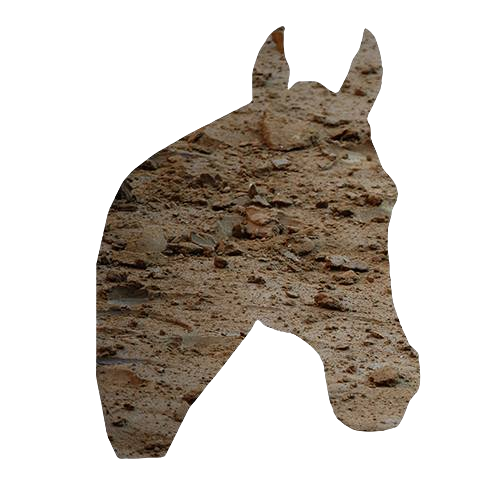www.thepalio.eu - dal Belgio con amore
Culinary Siena
Food and drink in Tuscany and Siena
It is my pleasant duty to say a word of thanks to Koen De Vocht who has been the eye of the Palio since 1999 with his unsurpassed and copious photo reports of the Palio: www.bbbc.be. Few photographers manage better to capture the space and atmosphere of the party among friends and acquaintances. Koen is an enthusiastic visitor to many Siena restaurants and assisted us with valuable advice.
This article is a reflection on Tuscan and Sienese cuisine, typical products and dishes, an attempt to solve a culinary problem, a concise overview of the spectacular innovation in the Tuscan wine world with indications of zones and top vineyards, and a critical but gentle eye on the qualities of Sienese restaurants and other dens of robbers where food is prepared.
Character of Tuscan cuisine and a dominant place in Renaissance Europe
Tuscan cuisine is a farmer’s kitchen that always uses local, good and fresh ingredients and rather simple recipes, with respect for the seasons, as arose in times without refrigerators and freezers. Tuscan cuisine is less refined than some other Italian regional cuisines and the word “simplicity” is quickly used to describe it, but it is not a contradiction to excellent.
Tuscany had a great European reputation from the 16th century when Caterina dei Medici married Henri II of France in 1553, became Queen and took her Tuscan cooks to the French Court. In the Middle Ages, the problem of freshness was solved by hiding first cooked and then fried food under heavily spiced sauces. In the Renaissance from the 15th century, many spices were still used, but less and new trends became noticeable: the entrails of animals were discovered, more milk and butter and cheese, but also fruit. More sweets, also jam and patisserie, often rich and elaborated.
Tuscan products and recipes
- Chianina beef
In the Val di Chiana, a border area of the provinces of Siena and Arezzo in Tuscany and the provinces of Perugia and Terni in Umbria, a very old breed of cattle has lived since Etruscan times, with a characteristic white coat, large and heavy. A cow weighs between 900 and 1100 kg. and measures 1.55 meters. A bull weighs up to 1700 kg with a height above 2 meters. Indeed, the Carroccio or float on which the Palio is fed in the Piazza is pulled by 4 Chiana bulls. Go and admire them in the morning before the race in their stable at the front in the Casato di sotto near the Piazza. The triumph of Chianina beef is of course the Bistecca Fiorentina, the ultimate T-bone steak. - Pici
A thicker version of spaghetti, made from just flour and water without eggs. At its best with a ragout from a local wild boar. - Crostini
Lightly toasted, salt-free bread topped with chicken liver paste. - Fagioli all’ucceletto
White beans with garlic and sage. The nickname for Tuscans in Italy is Mangiafagioli or Bean Eaters. - Pecorino or Cacio in the local dialect
Pecorino is a sheep cheese that you also find in Sardinia and Rome, and in several versions from very young (a few weeks) to very old (6 months) and crumbly. Spaghetti cacio e pepe is a local specialty. - Cantucci(ni)
Small, fairly hard almond cookies that are often savored by dipping them in a glass of vinsanto. - Finocchiona
Salami of pork and fennel seeds.
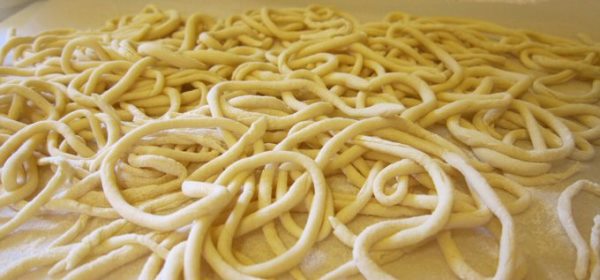
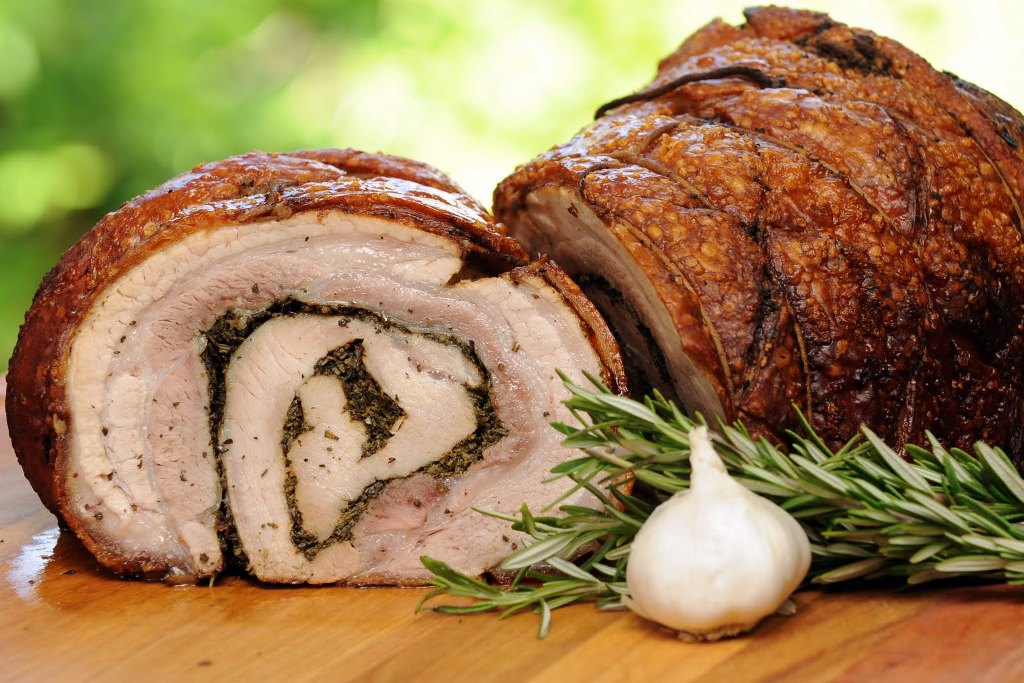
- Porchetta
Boneless, slow-roasted pork belly, seasoned. You sometimes buy it along the road from their version of chips: a cut slice between a sandwich. - Tuscan Bread
Unsalted, which is rather unusual for us. Some don’t like it, the undersigned are big fans of it. Advantages: it dries out very slowly and molds have no chance, and therefore have a long shelf life. Disadvantage : fast hard, for which the Tuscans have come up with 3 excellent solutions. - Ribollita
That is to say: cooked again. A very hearty soup based on soaked old salt-free bread, beans and other vegetables. Even better one day later. - Pappa al Pomodoro
A thick soup based on stale salt-free bread and tomatoes. - Panzanella
A salad of old salt-free bread, soaked in tomatoes, cucumber, capers, anchovies and fresh basil.
Sienese products
Since the end of the 19th century, Siena has built up a strong reputation as a producer of all kinds of cakes and biscuits that were made on a large scale and spread all over Italy. One could say as the Torinesi and the Milanesi have done with their famous aperitifs. Big names were and are Sapori, Pepi, Nannini, Parenti and Tinti.
- Panforte or Panpepato
Literally “strong bread”, because of the hardness but also because of the very spicy aroma. It is a Sienese invention, probably from the 13th century, first known as Panpepato or “peppered bread”, again because of the strong spices. A firm pastry based on flour, nuts, candied fruits (melon, orange), almonds, sugar, honey, and various spices, sprinkled with icing sugar. There are variations: the most famous is the Panforte Margherita, created on the occasion of the Queen’s visit to Siena in 1879, and now covered with a white vanilla sugar coating. Fairly hard but excellent. - Ricciarelli
Almond-shaped, lightly powdered almond cookies. - Cinta senese
A very old, medium-sized pig breed, immortalized as early as 1337 by Ambrogio Lorenzetti in his famous Buon Governofresco: black fur with a characteristic light band or “cinta” over the shoulders, flanks and front legs. The local prosciutto is also made from this, sweeter than the classic from Parma or the San Daniele from Friuli, but excellent. - Trippa alla senese
Cow stomach with a tomato sauce
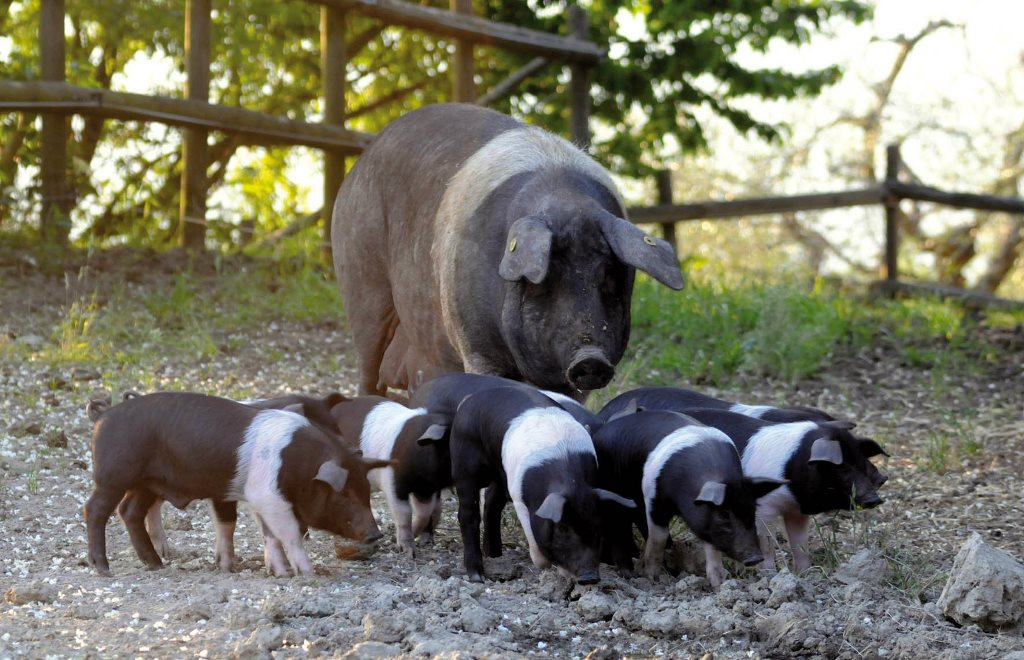
The “Tiramisu” myth
Tiramisu is sometimes presented as a Sienese invention. Nothing could be further from the truth and no one in Siena claims the invention. Even worse, Tiramisu is a very recent culinary invention. You will find the recipe for the first time in a cookbook from 1980, and it is believed to have been created not before the end of the 60s and even earlier 70s of the 20th century.
But Tiramisu may have a Sienese source of inspiration that was different. Unfortunately, one does not have absolute certainty, but there are a number of beautiful legends, which may contain a grain of truth because there is a certain logic in the story.
A first version speaks of a diplomatic visit of duca or duke Ippolito da Correggio to Siena in 1552, on behalf of Cosimo I, duca of Florence. It was a very delicate moment in the history of the independent Republic of Siena, because it had revolted against the Spanish Habsburgs and the danger came mainly from Florence. So Ippolito had to be well received and they prepared him a Zuppa del Duca or “Soup of the Duke” which was actually a dessert.
The second version says that it only happened during a visit to Siena by Granduca or Grand Duke Cosimo III of Tuscany at the end of the 17th century. After all, in 1555 the republic had fallen to Florence and was incorporated into the Grand Duchy. And since the duke loved sweets, the Sienese pastry chefs prepared a common dish: la Zuppa del Duca.
It certainly couldn’t have been a kind of Tiramisu because the ingredients were unavailable: coffee, mascarpone and savoiardi biscuits. The first coffee house is said to have been founded in Italy in the 16th century. It could therefore still be possible, and certainly in the 17th century. Mascarpone is a fresh cheese from Lombardy, which was almost certainly not transported to Siena at the time, and the same goes for Piedmontese Savoiardi biscuits. However, the versions may be true because Zuppa del Duca is composed differently.
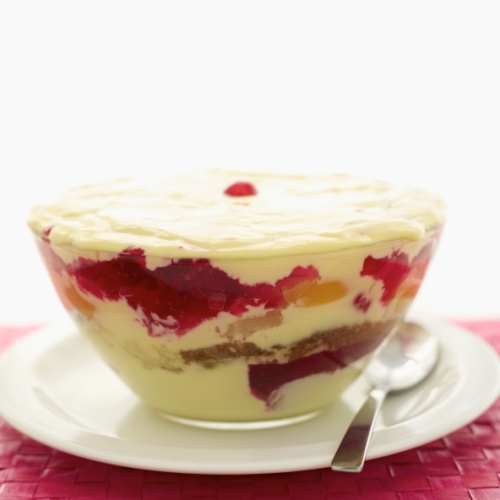
The duke took the dish to Florence, and it spread throughout the Veneto and Piedmont. In Venice it is called a Venetian creation that women gave to their men in the evening to give them enough energy, and in Treviso near Venice it is said to be an invention of a restaurant near a brothel.
Anyway, in the 19th century an important Anglo-Saxon community settled in Florence, consisting of well-to-do English and American families with a great passion for art and literature, but who also liked to be pampered culinary in chic patisseries such as Doney in the Via Tornabuoni, including a dessert Zuppa del Duca that suddenly changed its name to Zuppa Inglese or “English Soup”.
The dish appears in the bible of Italian cuisine, La Scienza in Cucina e l’Arte di Mangiare bene by Pellegrino Artusi from 1891 as Zuppa Inglese under recipe number 675. For enthusiasts: in 2013 Artusi was republished in a beautiful Dutch edition.
Restaurants in Siena
One will never go hungry in Siena. The city is full of large and small restaurants and eateries, rarely of questionable ones, usually of rock solid and sometimes of excellent quality. And an additional pleasant feature is that the price tags are very moderate, especially compared to our country and also to other Italian tourist destinations.
Restaurants in Italy used to be strictly divided into categories, depending on the nature of the organization and layout and not necessarily on the quality of the food. A ristorante was very formal and had a menu and smartly dressed staff. A Trattoria was less formal, usually run by a family and sometimes had a menu. An Osteria was even less formally decorated, had no menu and made a changing daily special. At a Vinaio, people first and foremost went to drink a glass of wine and sometimes they could risk their life by eating something. These categories only exist in name and have nothing to do with a qualitative assessment of quality, design or price. The best restaurant in Siena is an Osteria. Foreigners have discovered the best but Sienese keep coming.
We start with the simple heirs to the vinai and osterie of yesteryear.
- Il Grattacielo
The “Skyscraper”, and you have already guessed that you almost have to bend down to stand inside it. Probably the smallest eatery in town with an often exuberant audience. During the Palio days, tables are placed outside under an arcade. Made world famous in 1986 through an article in The Times. Now young owners who mainly make fresh simple dishes (sometimes something warm during the Palio days). You choose at the counter : prosciutto e melone, acciughe sotto pesto,… Recommended.
Via Pontani 8, from Via Banchi di Sopra under the arcade and on the corner of Via dei Termini. - Osteria Il Vinaio di Bobbe e Davide
Similar to but larger than the “Gratta”. Top quality of salumi and formaggi. Correct, cheap wine. Disadvantage: is a bit away from the center, but quality, price and service deserve an extra 500 meters. Highly recommended.
Via Camollia 167 - Osteria Trombiche
Historic osteria, modernized, very small, many people.
Via delle Terme 66
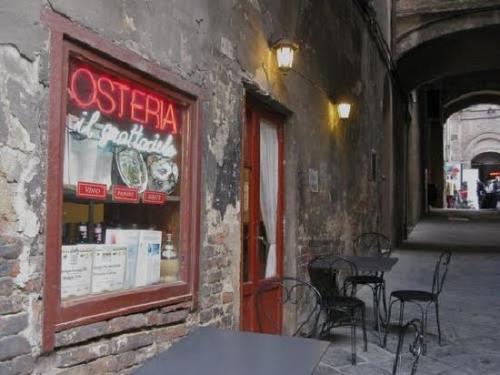
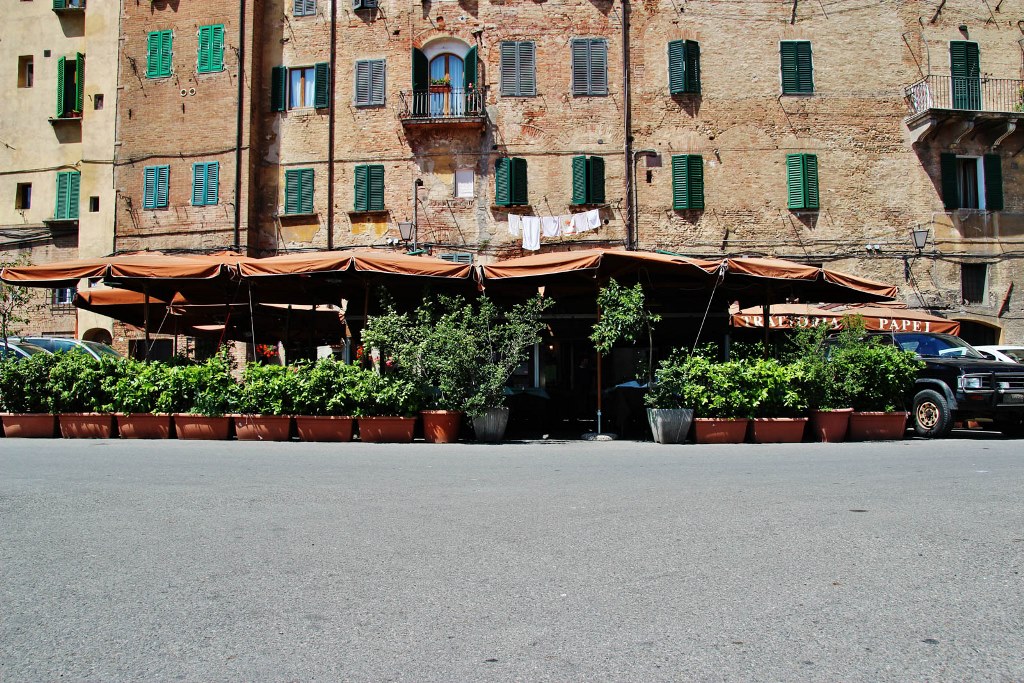
Siena’s strength lies in a whole series of excellent restaurants, sometimes simple in decor, but where one rarely or never does anything wrong, on the contrary, and where the owner closely monitors correct quality, and where the price is very correct.
- L’Osteria
Restaurant of the imperturbable Beppe van Bruco. Very simply furnished. Top quality Bistecca fiorentina, but try the Bruschetta gorgonzola tartufo and the Pici cacio e pepe. House wine, cheap and always very correct. Or as Koen De Vocht puts it: eating there is like coming home. Correctly priced and highly recommended.
Via dei Rossi 79, side street Via Banchi di Sopra under the arcade next to Feltrinelli to Bruco. The arcade stunned the late Wannes Van de Velde when he first came to Siena at the invitation of the VRT. - Da Papei
An institution! Located behind the town hall on the square that separates Torre and Onda and has been silent witness to top riots. Huge terrace and still best to reserve in the summer because always packed in several shifts. Operated by Roberto Papei, ex-capitano of Civetta who guided them through difficult years with great dignity. The pinnacle of rock-solid Sienese farm food: Pici alla cardinale or cacio e pepe, Pappardelle al cinghiale, Tagliolini al sugo d’anatra or di coniglio, and Tagliata (small pieces of beef) di arugula or alla montalcinese. Very correct cheap house wine. Highly recommended, also for its view and atmosphere.Piazza del Mercato 6, behind the Piazza del Campo and the Town Hall. - Nonna Gina
Unpretentious mother-daughter cooking tradition : good bruschette, Pici alla Dado, best Salsicce (sausages) in town.
Via Pian dei Mantellini 2, further from the centre, to the south via the main street Via Banchi di Sopra, which becomes Via di Città and Via di Stalloregi. - Il Carrocco
At the front of Via del Casato near the Campo. In summer with large tables in the street. Very correct kitchen.
Via Casato di sotto 32 - Grotta di Santa Caterina, da Bagoga
Ex fantino of the Palio. Since 1973 cook with considerably more success.
Via della Galluzza 26 - Boccon del Prete
From the outside you only see a door. So it is not big, but there is a nice medieval cellar, and above all an excellent, very affordable kitchen.
Via San Pietro 17, south via Via di Città and to the left.
We go one category higher: restaurants with a more selected menu, also slightly more expensive but very reasonable by Belgian standards.
- Antica Osteria Da Divo
It is not given to every restaurant : you can choose whether you want to eat in a suggestive medieval room above a “pozzo di butto”, a waste pit protected by a glass plate, or in a room that is 2500 years old, ie carved in Etruscan tuff , i.e. a soft volcanic rock. The menu is very neat and even refined.
Via Franciosa 25-29, street that starts next to the baptistery. - Da Guido
This used to be Siena’s top restaurant, and the beautiful interior is full of photos of Italian opera stars and other luminaries from the world of classical music who came to Siena, invited by the Academia musicale Chigi. Nice menu and generally excellent.
Vicolo Pier Pettinaio 7, side street of Via Banchi di Sopra.
And finally the toppers, with exquisite menus, expensive by Italian standards, less by Belgian standards.
- Le Logge
This exquisite restaurant was created by the late Gianni Brunelli, the exuberant chef and winegrower in Montalcino, and is now continued with great panache by his wife Laura. It is “the place to be in Siena”, and not only for its cuisine, as it is frequented by top international politicians, artists and writers, etc… The menu is always excellent and Brunelli wines are recommended. Reserve for outside in the summer or inside downstairs. The upper floor is less attractive. Recommended.
Via del Porrione 33, side street of the Campo. - Tre Cristi
This is the continuation of the historic Tullio ai Tre Cristi restaurant.
Vicolo Provenzano 1-7, near the church of Provenzano
A very last note about the price of wines in Sienese and Tuscan restaurants. The time when we sometimes had the pleasure of paying less for a bottle of wine in a restaurant than in a shop is unfortunately over. From 1990, people started asking for 10 to 30% of the retail price. Nowadays people ask for a minimum of 30% to 80% on top of the retail price. 300% or more on top of the price, as we often experience here, has never been heard of in Tuscany, and let’s hope it stays that way. This means that if you drink a bottle of 30 euros in a restaurant, you are not drinking wine from 8 to 10 euros, but rather from 17 to 22 euros. Consider this a custom but not a law.
TUSCANY WINES : the revolution of Piero Antinori and Giacomo Tachis
Older readers still remember the spherical wicker basket bottles that flooded Belgium after the Second World War. Cheap Chianti with usually a ditto taste.
And then the light appeared in the person of Piero Antinori and Gioacomo Tachis.
In 1385 the Antinoris became members of the Florentine wine guild and Piero is now the 26th generation of winemakers. He was born in 1939, studied economics and took over the management of the family business in 1965. In 1961, his father Niccolo had hired a young man from Piemonte as a junior winemaker : Giacomo Tachis, born in 1933, graduated as a winemaker in Alba but with his eyes wide open to the evolution in Bordeaux where they were several centuries ahead of Tuscany.
Piero and Gioacomo quickly found each other and in 1968 they visited the vineyard of Nicolo’ Incisa della Rocchetta, Piero’s cousin. Mario Incisa della Rocchetta, Nicolo’s father, had started making his own wine in 1948 in Bolgheri, not far from the Tuscan coast, an area considered unsuitable for viticulture. The wine was for home consumption and for the farmers on the domain, but was not commercialized. The rest is history. Piero convinced Nicolo’ to market the wine and Gioacomo Tachis became the oenologist : Sassicaia was born, a giant in the wine world. The 1968 vintage was released in 1971 and was immediately hailed as a sensation. But there was a big problem: the wine was made from Cabernet Sauvigon, a Bordeaux grape, and Italian wine making was very strict about what was allowed or not to get an official designation. So the first so-called SuperTuscan was labeled with Vino da Tavola as if it were an ordinary table wine.
Piero Antinori was convinced that everything had to change within his company in order to compete at a high international level, so he had Tachis produce Antinori’s first Vino da Tavola, the almost equally legendary 1971 Tignanello : a blend of the local Sangiovese but with Cabernet Sauvignon, the first Chianti wine without the mandatory addition of white grapes to be recognized as Chianti Classico, and the first Sangiovese to be aged in barriques. A second SuperTuscan was born, to the dismay of the local winegrowers and the official authorities, followed in 1978 by the spectacular Solaia.
And Piero Antinori continued : he left the Consorzio del Chianti Classico in protest against the outdated methods. Around 1840, Baron Bettino Ricasoli of the famous Brolio castle near Gaiole in Chianti had made the right blend of what he believed to be a good Chianti: 70% local Sangiovese, with red Canaiolo and white Malvasia and Trebbiano. The Consorzio del Chianti Classico made this composition compulsory in 1932. But what should have been an incentive for quality turned out to be the biggest obstacle. Especially the obligatory white grape and slightly lesser quality red grapes, and the outdated production methods were a serious handicap.
Piero Antinori found allies. Other Tuscan winegrowers started making Vino da Tavolas with a Super Tuscan level such as Le Pergole Torte from Montevertine near Radda. Tachis also started advising other winegrowers : Castello dei Rampolla in Panzano improved its Chianti Classicos in a short time, although still according to the outdated principles.
And more happened. In areas previously considered unsuitable for viticulture, new wineries were started, inspired by Sassicaia in Bolgheri, but also by the audacity of Piero Antinori and the modern approach of Gioacomo Tachis.
Lodovico Antinori, Piero’s younger brother who was bought out by Piero, bought land at Bolgheri and created new toppers: Ornellaia and Masseto. Grattamacco and Tua Rita and many others were started up in the coastal area below Bolgheri. Especially the story of Rita Tua, a lady from Bologna, is a disconcerting example of initiative and innovation. She and her husband Virgilio bought a piece of land in Suvereto 6 km from the Tuscan coast in 1984 to live in nature, only then became passionate about wine, worked on barely 2 hectares and in 1992 produced her first top wine Giusto dei Notri and in 1994 her first Redigaffi, become a legend and the first wine that Robert Parker, the feared wine guru 100 out of 100.
The revolution was unstoppable and gradually the Italian state gave in. The old wine regulations were relaxed, new “appellations” were created and the Vino da Tavola became IGT or Indicazione Geografica Tipica or Typical Geographical Indication in 1992, comparable to the French Vin de Pays.
And yet Giacomo Tachis, the great revolutionary, was also someone who sometimes warned against excesses: don’t just rely on modern technology; Sangiovese is the future of Chianti, he spoke prophetically at a time when everyone there began to produce wine with Cabernet Sauvignon and Merlot, as he had once done.
Giacomo Tachis passed away on February 6, 2016. If you want to learn more about the importance of this man, you can find information via google on the sites of Decanter and The New York Times. I met him once, shortly after 2000 at a wine fair in Brussels. He was simplicity and friendliness itself, exactly as he looks in the photos.
WINES of the Province of SIENA
The winegrowers in the province of Siena have adapted to the new developments since 1970 and often played a decisive pioneering role.
There are 5 main zones in the province of Siena :
CHIANTI CLASSIC
This is the area between Florence and Siena, bounded in the west and east by Poggibonsi and Montevarchi. The Chianti Classico is divided into sub-zones of which the core area, the “Chianti Storico” with Castellina, Gaiole and Radda, belongs to the province of Siena. The other sub-areas of the Chianti Classico were only added in 1932, including Poggibonsi and Castelnuovo Beradenga of the province of Siena. Other well-known zones are Greve, Panzano and San Casciano in the province of Florence.
Almost all wineries make a Chianti Classico as base wine, a better Chianti Classico Riserva, an even better Chianti Classico Gran Selezione, one or more IGTs where local and foreign grapes are mixed and which are often the best they have to offer and therefore the description Get SuperTuscan, and sometimes white wines. With a few exceptions, Tuscany is not known for its good white wines. The vinsanto and especially the grappa are often not missing from the range.
The label Chianti Classico Gran Selezione requires some explanation because it is a brand new phenomenon. In February 2014, the first wines of this new label were presented with the vintages 2010 or 2011. Winegrowers have been struggling for years with the problem of a good label, so important for marketing. In the past, there was a Chianti Classico, a basic wine that must mature for 12 months, and a Chianti Classico Riserva from the best plots that had to mature for a minimum of 21 months in barrel and 3 months in bottle. The system worked reasonably well but was not watertight. A producer could afford to let wine from a lesser plot mature longer and it became a more expensive riserva. Subsequently, the market was flooded by all kinds of “new” wines, often of top quality, the Supertuscan, first with the label Vino da Tavola and then finally IGT since 1992. But less and less was unpacked with a collective name to present wines with a dominant “own” grape from an “own terroir”, ie the sangiovese. An attempt to break this individualistic tendency came from some top winegrowers proposing a Chianti Classico denomination Castello di Fonterutoli or di Ama or di Monsanto , etc… in imitation of the French Châteaux, but the project stalled because other important houses did not have a castle.
Gradually the idea of a Chianti Classico Gran Selezione grew, a wine based on a minimum of 80% Sangiovese, the most Tuscan grape, not necessary but possibly to be mixed with other Tuscan or foreign grapes, from the best plots of the vineyards and that have a minimum of 30 months to mature. New problem: if we were to do this, wouldn’t we compete with our own SuperTuscans and our Riservas? Or shall we risk renaming our SuperTuscans or Riservas and making them a Gran Selezione? In addition, some favored wines from a single vineyard, but most accepted a blend from several lots.
There was a lot of confusion when the first vintage based on the 2010 and 2011 harvests was presented in February 2014 in Florence. Because of the dilemmas mentioned above, there was also doubt about the prior strict selection by a committee of experts. Of the approximately 100 wines offered, 35 were ultimately selected from 33 different vineyards. It is believed that quality with an emphasis on finesse and balance was the main criterion, and since the average alcohol content was 14.25%, the committee will also have had a preference for very mature wines. It rained polemics. Someone commented that the wines from around the hamlet of Lamole had been excluded because they were lighter but also wonderfully perfumed and the committee preferred richer wines.
Wine critics were also very suspicious and suspected a flat marketing trick and thought that the conditions should have been stricter. But what did the contents of the bottles say? Wines of very high and sometimes exceptional quality were tasted, on average far above the old riservas.
The second vintage was presented in 2015, mostly harvests from 2012, and this time 89 wines had already been accepted by the committee. The points of discussion have not been resolved, but this growth proves that the Gran Selezione is a direct hit. A first consecration followed in November 2015 when the authoritative American wine magazine The Wine Enthousiast declared the Chianti Classico Gran Selezione Il Grigio di San Felice 2011 from the Sienese zone Castelnuovo Berardenga the best wine in the world of the year based on the relationship quality/price , and that after having tested 19,800 wines! The wine is not cheap, between 20 and 45 euros, but already in the bottom group you will find amazing quality.
I give you a list of the better vineyards as usually found in specialized publications. The very best are in bold. I will immediately add that several unnamed producers are often equally good.
Castellina in Chianti
- Castello di Fonterutoli, lead producer with IGT Siepi and Mix36. This new wine is the result of nearly 40 years of experimentation and cloning with 36 Sangiovese varieties.
- Castellare with IGT I Sodi di San Niccolo
- Rocca delle Macie
- Fattoria Lornano
- Lilliano
- Cecchi
- Villa Pomona Bandini
According to specialists, the wines from Castellina have a delicate aroma and taste.
Gaiole in Chianti
- Castello di Ama, leading producer with IGT Villa l’ Apparita
- Ricasoli (Castello Brolio), leading winery founded by Barone Ricasoli, “inventor” of the “right” blend to make Chianti Classico, well-intentioned but with negative consequences. In 1861 he became the second prime minister of young Italy. IGT Casalferro
- Rock of Castagnoli
- Riecine
- Badia a Coltibuono
- Rocca di Montegrossi, also from Ricasoli
- San Vincenti
- Agricoltori Chianti Geografico
According to the specialists, the wines from Gaiole have a nice structure and firm tannins.
Radda in Chianti
- Brancaia, leading winery with IGT Brancaia Blu
- Montevertine, Sergio Manetti launched the first vintage of his IGT Le Pergole Torte in 1980, becoming one of the first Tuscan winegrowers to understand the revolution initiated by Antinori and Tachis. In 1981 he left the Consorzio and never made another Chianti Classico.
- Castello di Volpaia
- Livernano with IGT of the same name
- Il Poggerino with IGT Primamateria
Castelnuovo Berardenga
- Felsina with IGT Fontalloro
- San Felice with IGT Vigorello
- Poggio Bonelli with the IGT Poggiassai
- Castell’ in Villa with IGT Santacroce
According to the specialists, the wines from Castelnuovo Beradenga are the most ripe and have the richest taste.
Poggibonsi
- Melini
CHIANTI COLLI SENESI
These are wines from a small area around Siena, and from the area around San Gimignano, more known for the white Vernaccia. Some decent but no real top wines are made.
- Tenuta di Trinoro is located in Sarteano, 58 km away. south of Siena. The eccentric, visionary owner Andrea Franchetti does not make Chianti, but does make some formidable IGTs such as Tenuta di Trinoro, Le Cupole and Palazzi, in a place where wine was not made. He only started from scratch in 1992, and only grows French grapes.
VINO NOBILE DI MONTEPULCIANO
This is a limited area that extends around Montepulciano 56 km south of Siena and also towards Cortona.
- The basis of this wine is the Nobile grape, a variant of the Sangiovese. They also make a simpler and cheaper Rosso di Montepulciano.
- Poliziano with IGT Le Stanze
- Boscarelli
- Cerro
- Salcheto
- Avignonesi , operated by Virginie Saverys of the eponymous shipowners family from Temse. Her vinsanto has to be just about the best dessert wine in Italy.
- Angelini
- La Braccesca (from Antinori group)
BRUNELLO DI MONTALCINO
Montalcino is a mountain village 32 km south of Siena.
- The Brunello did not need the Antinori revolution to be recognized as the oldest true top wine in the province, but it has benefited from technological innovations and some IGTs have also been produced.
- The Brunello grape is also a variant of the Sangiovese, also known as Sangiovese grosso. In addition to the Brunello, they also make a cheaper young wine, the so-called Rosso di Montalcino, sometimes amazingly good.
- Tenuta il Greppo Biondi Santi, in Montalcino they only made a sweet white wine based on demuscat grape, known as Moscadello di Montalcino. And then Ferruccio Biondi Santi started a wine revolution. In 1865 he made his first Brunello, a clone of Sangiovese, also known as Sangiovese Grosso. His work was continued by son Tancredi and grandson Franco, and until the revolution of Antinori and Tachis, this was the only really great, even legendary Tuscan wine.
- Casanova di Neri
- Soldera Case Basse with extraordinary IGT’s Pegasos and Soldera. Gianfranco Soldera is the region’s most idiosyncratic and brilliant winemaker.
- Castle Banfi
- Poggio Antico
- La Cerbaiola Salvioni
- Cerbaiona
- Lisini
- Podere La Fortuna
- Canalicchio di Sopra
- Frescobaldi Castelgiocondo
- Argiano with IGT Solengo
- Donna Olga
- Le Chiuse di sotto di Gianni Brunelli, from restaurant Le Logge in Siena
- Caparzo
- Sir Pacenti
- Valdicava
- Poggio di sotto
- Poggio il Castellare Baroncini
- Silvio Nardi
- Il Poggione
- Pian delle Vigne of the Antinori group
VERNACCIA DI SAN GIMIGNANO
Tuscany is not known for excellent white wines. The Vernaccia comes closest to real quality without reaching the level of the white wines from Alto Adige, Friuli and the Veneto.
- Vincento Cesani
- Guicciardini Strozzi fattoria cusona
- Panizzi Giovanni
- Rampa di Fugnano
- Teruzzi e Puthod with a separate terre di tufi based on chardonnay and sauvignon
- fattoria di Pietrafitta
- Fontaleoni
Restaurants in the Province of Siena
It would take us too far afield to go into detail here. After all, all those tourists who are on a farm in Tuscany need to be fed, and restaurants are being started everywhere in often surprising and not easy to reach places, from cheap-simple to sometimes exclusive-expensive, at least by Italian standards. And a rare tourist trap. You will also find restaurants at many vineyards.
I do want to testify that, like in Siena, there are many excellent Tuscan farmhouse restaurants that do little wrong and achieve an excellent price-quality ratio. Most have a house wine, often simple but correct. Sometimes very correct. For a few years we drank a house wine of 5 euros for 1 liter in San Quirico d’Orcia. The wine was so abnormally good that the owner confessed afterwards that he had bought a stock of Rosso di Montalcino that had gone unsold for years. Unfortunately, that does not happen everywhere.
I’m going to suggest a small random selection that we have fond memories of.
- Bar dell’Orso
Close to the exit of the superstrada Firenze-Siena and before and below the castle is the legendary Bar dell’Orso. The bar opens at 5 o’clock and closes at midnight and in the meantime the food is a delight. No menu, best choose first at the bar. Simple, top quality cold dishes : prosciutto e melone, great porchetta, Acciughe sotto pesto. Don’t be alarmed by the public: the bar has been discovered by tourists, but strange birds sometimes roam around. An experience of a separate food culture.
Monteriggioni, hamlet of La Colona, Via Cassia Nord 23 - Antica Trattoria La Torre
This was originally a simple farmhouse restaurant. It has somewhat retained its character although it has become a rendezvous for the elegant foreign colony that resides nearby.
Castellina in Chianti, Piazza del Comune 15 - Il Re Gallo
To the right of the medieval town hall. Exquisite and varied cuisine and a nice correct wine list. Make reservations , especially if you want to sit outside .
Castellina in Chianti , Via Toscana 1 - Carlino d’Oro
Utterly unpretentious restaurant below Brolio Castle in the hamlet of San Regolo of Gaiole in Chianti. Many satisfied clients according to the internet. - Bar by Paolo Gaeta
For once, I’m going to name an eatery outside the province of Siena. On the road from Siena to Firenze in Panzano turn left at the bottom of the village near a small square and follow the steep road up. Turn left at the church, 200 meters further there is a parking lot. Go back to the church. The bar is on the corner over the church. Nothing special, a long pipe but on the terrace you can eat small dishes (good salsicce) and drink excellent wines by the glass at a price for which you get wine that can make you blind. From the terrace you have a stunning view of the vineyards of Panzano.
